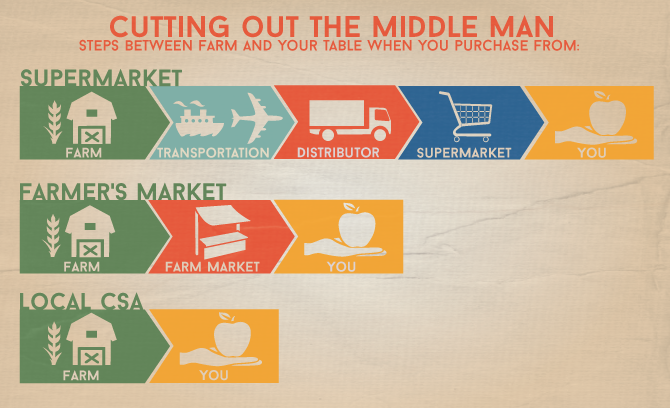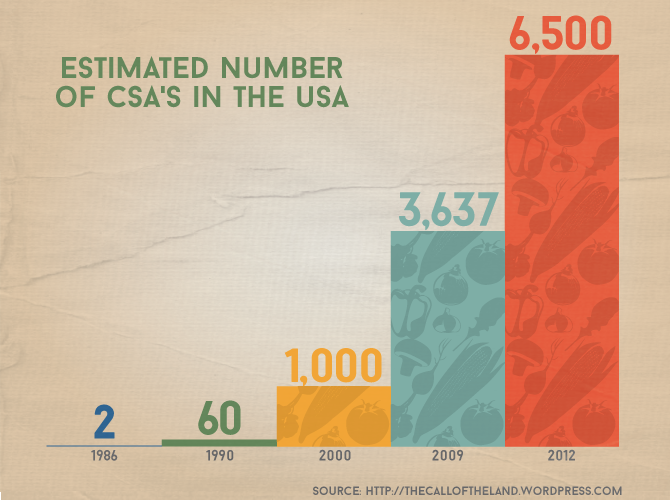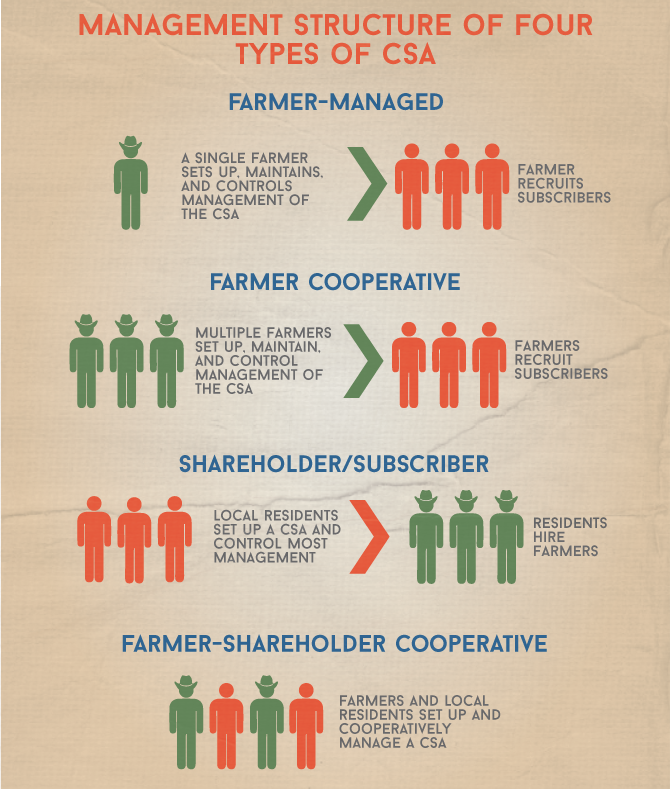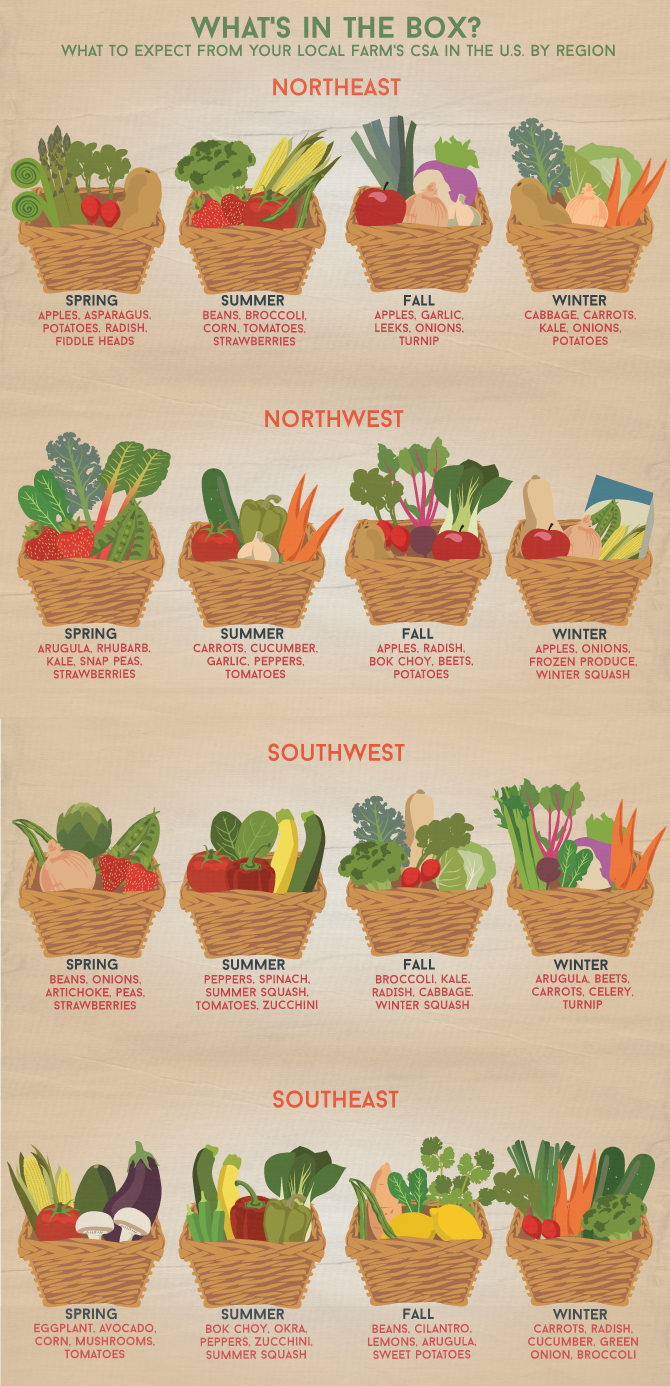From Farm to Table
Bring the Farm Closer to the Plate With Community-Supported Agriculture
I grew up in the city, and like most urbanites the closest I got to a farm was the produce section of the supermarket. Barring an elementary school field trip or two, we don’t often have the pleasure of shaking hands with our food producers, and doing just that would require a costly tropical trip if we’re buying bananas and papayas. Given widespread food recalls from contamination and questionable factory farming practices, it’s in our best interest to know exactly where our food comes from and how it’s produced. The easiest and most delicious way to do this is to go local. Luckily for us city folk, we have the bounty of farmers’ markets and now CSAs (community supported/shared agriculture) to bring the farm directly to our kitchen table.

Loco for Local
The local food movement is a throwback to the days when foreign food wasn’t flying across the globe, losing nutrients and wasting fuel. Farmers’ markets and CSAs cut out the middlemen – transportation and storage – and bring us back nutrient-rich, farm-fresh food that changes with the seasons. Now we rely on what can be successfully and consistently grown, harvested, and preserved on the land around us based on our climate instead of snubbing the seasons and supplanting locally grown food with our favorites from abroad. But while most of us have perused the stalls of a farmers’ market hand-picking our favorite treats, fewer know about the amazing opportunity that is the local CSA.
PSA for CSA’s
Community-supported agriculture is exactly what it sounds like. You, along with other members of your community, support a particular farm or farms by purchasing food shares before the start of the growing season, then enjoy the spoils as the growing season unfolds. If this idea is new to you, it’s likely because CSAs are a relatively new model in North America, growing from only two farms in the U.S. in 1986 to more than 6,500 in 2012. (Check LocalHarvest for a CSA near you!) This recent growth is telling – CSAs work. The mutually beneficial business model takes many forms depending on the needs and capabilities of both the farmers and shareholders, but ultimately everyone wins.

Risk and Reward
The most common business models are farmer or farmer-cooperative CSAs, where the farmer shoulders the bulk of the management responsibilities and the shareholder is treated more as an investor. There’s risk in any investment, and CSAs are no different. When you purchase a share, you’re providing capital for the farmer to purchase the seeds, supplies, and labor required to fill your box with food for a prescribed period of time – and you also agree to take the good with the bad right alongside them. So when the weather is particularly favorable and crops are bountiful, you’re rewarded with extra food. However, if crops are damaged by hail, insects, or disease, you may have weeks or months with lighter loads. Is it worth it? Well, think what would happen to the farmers if they weren’t supported by their community when the going got tough: no more food. Period. So your investment isn’t just a short-term exchange for food, but a long-term one that aims to keep farmers in the black gold for years to come.
The Good, the Radicchio, and the Ugly
If you’re ready to take the plunge, the first thing you’ll notice is that CSAs come in all seasons and sizes and completely depend on your location and the capacity of the farm. I’ve seen shares of dairy, meat, fruit, vegetables, and eggs (even flowers) both big and small, full-year and month-long. But despite their differences, there are a few commonalities.
1. Good quality. This is really the freshest and the best that farmers have to offer, delivered directly to your doorstep (or more commonly a pre-arranged pick-up location). If you ever do get a bag of dud spuds, you can often arrange for a replacement in the next share. These are good people who want you to love their food.
2. Variety. Most CSAs kindly provide a list of your share’s contents via newsletter before you pick it up. This is an immense help to meal planning and also a great way to introduce yourself to new products with debatable pronunciation. Celeriac, anyone?
3. Ugly buglies. You will undoubtedly open your mystery box and see a few five-legged parsnips and the occasional worm peeking up from your lettuce. This is normal. Farmers produce food to be eaten and enjoyed, not to be plasticized on the front page of a glam mag. Insects are an important part of the ecosystem and often, ugly just tastes better.

Solving the Mystery Box
No doubt your first few mystery boxes of food will be intimidating, but they can also be inspiring. Here are a few tips to make the most of your share as you adjust to your new-found bounty.
1. Plan ahead. Getting your share is like instant grocery shopping, but unless you’ve joined a super CSA, there will still be items on your shopping list. Find out from your farmers what foods you can expect when and plan your meals accordingly. Coordinating your share pick-up with a grocery trip is another great way to save time.
2. Get to work. You may be getting a few weeks’ worth of food in your share, and if your vegetables need washing, peeling, and chopping, aim to do it right away. If it looks like too much food altogether, use your freezer to preserve your food to enjoy another day.
3. Look it up. If the kohlrabi has been giving you the evil eye from the back of the fridge for a month now, you’re probably lacking a good recipe. Look online for tips, tricks, and instructional videos to deal with the most puzzling produce. Your fellow shareholders are another great resource.

Finding the Right Fit
Joining a CSA is an amazing way to connect with your community and inject some intrigue into your cooking routine, but it does require a change in lifestyle. If you’re on the fence about joining, talk to the farmers at the market and see what they offer. Any investor worth their salt would want to understand what they are financing! Another option is to start small by selecting a smaller share or sharing a larger one with your neighbor. If you find yourself getting jealous of the bigger boxes or arguing over who gets the asparagus, you’re probably ready to upgrade.
Ultimately, though, our goal should be to eat healthy, local, farm-fresh food and to support those that provide it. CSAs and farmers markets are both fantastic choices for filling your plate, but there are also butchers, bakers, coffee shops, and restaurants that share the same ideals. Check Sustainable Table’s Eat Well Guide to discover your community’s purveyors of local, sustainable, organic food options, and choose the ones that suit you best, the ones that you and your family can enjoy and sustain for years to come.
Embed the article on your site

